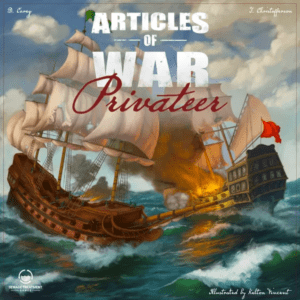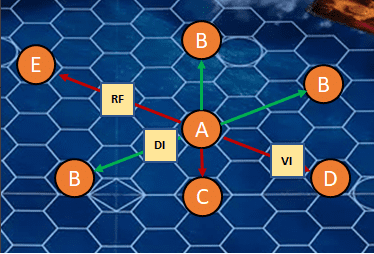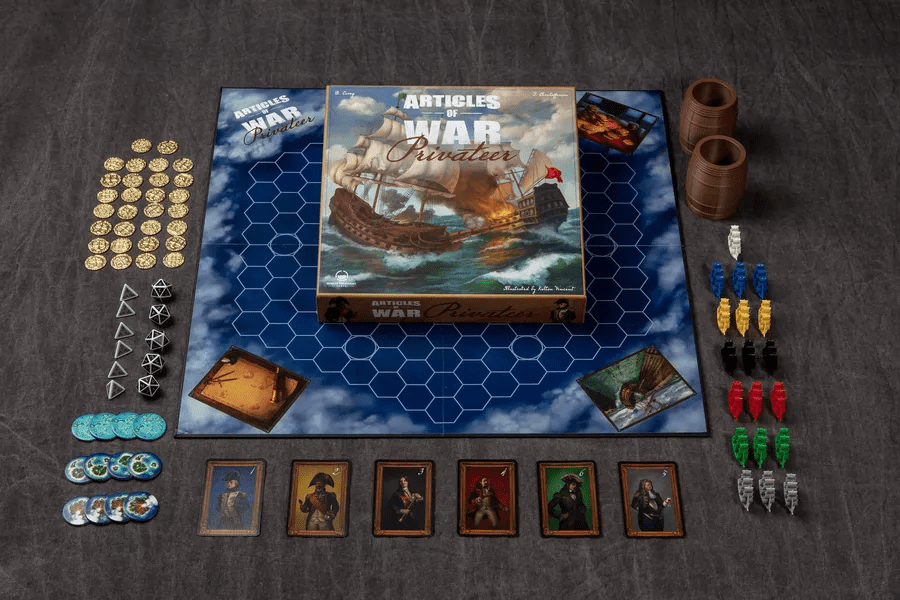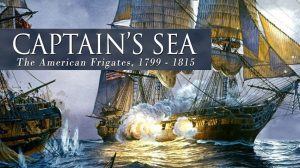Sewage Treatment Games – gotta love that name – provided Meeple Mountain with a prototype copy of Articles of War: Privateer, or AoWP for short. The game is planned for release later this year, and according to the publisher, is going to be the first in the Articles of War series. In AoWP, each player commands 2 or 3 ships and attempts to win the most loot by sinking other players’ ships. They can also try to board and capture other ships and add them to their fleet.
What is, or was, a privateer? A privateer was a privately owned vessel given a commission, commonly known as a Letter of Marque, by their government to raid merchant vessels of enemy combatants. Although the practice of authorizing privately owned ships to prey on enemy ships dates to at least the 13th century, the term privateer – which applies equally to the ship and its crew – did not come into use until the mid-17th century. Sir Francis Drake and Walter Raleigh are perhaps the most well-known privateers in history, if not the most successful. The 1856 Declaration of Paris effectively abolished privateering by European powers, although Prussia did flirt with it briefly during the 1870 Franco-Prussian War.

Getting Ready to Play
Begin by placing the white merchant ship in the center of the board. Players then randomly select a Commodore card which indicates their place in the turn order and the color of ships they will use. Each player starts with 2 ships. In turn order, players place one of their ships on a starting space on the board, and their second ship in any adjacent space. Players can then spend the 2 gold doubloons they start the game with to purchase a third ship. This is entirely optional.

The player going last then determines how many islands will be placed on the board, two, three or four of each type. Islands come in three varieties: volcanic islands, desert islands, and reefs. Ships cannot enter volcanic or desert island spaces. If they do, their ship is sunk. Ships can pass over reefs if they survive a die roll. Ships can fire through hexes with a desert island or reef, but not a volcanic island. The selected number of islands are put in one of the barrels and, in turn order, players draw an island and place it on the board at least two spaces aways from enemy ships, although they can be placed adjacent to the player’s own ships or another island.
Game Play
AoWP uses what the publishers refer to as a “dice economy” to regulate game play. In turn order, players select two dice for each ship they have in their fleet. There are two types of dice: 4-sided Sail dice that regulate movement and 20-sided Cannonball dice used for combat. Of the two dice selected for each ship, one must be a Sail die. Therefore, if a player has two ships his options are (1) 2 Sail dice and 2 Cannonball dice, (2) 3 Sail dice and 1 Cannonball die, or (3) 4 Sail dice. The selected dice are then put in a barrel and rolled. Players can then spend the dice in any manner they wish, and in order, provided each ship uses at least one Sail die.

Each Sail die rolled will yield either a 2, 3, or 4 (there are no 1’s, and two 2’s). To use a Sail die, players select one of their ships and move it in a straight line a number of spaces equal to the die roll. Players must be careful to use their dice in a manner that keeps their ships from running aground on an island. Any ship that runs off the edge of the board is also removed.
Cannonball dice are used to fire on enemy ships. Each die must be fired at a space exactly the number of spaces away as shown by the die, and only in a straight line as shown in the diagram below. If those two conditions are met, congratulations, you just sunk the enemy and will be awarded a gold doubloon. However, your Letter of Marque only applies to enemy ships.

The arrows indicate the only valid directions in which a ship located at A can fire. If the ship uses a Cannonball die with a value of 3, it can fire at all ships in spaces designated with a B. They are all in a straight line and exactly 3 spaces away from A. The desert island (DI) does not block fire since desert islands can be fired over. The ship at C cannot be fired on because it is only 2 spaces away. The volcanic island (VI) at D blocks the fire on the ship located at D. And while the reef (RF) doesn’t block fire, the ship at E is 4 spaces away.
Players can also attempt to seize enemy ships, or the neutral merchant, via a boarding action. This is done by moving into or through a space containing the other ship. Each ship rolls a single Cannonball die. The ship rolling the highest wins the boarding action. Do not roll for the merchant – they automatically surrender if boarded. The losing ship is removed and is replaced by one of your own color. No doubloons are awarded for seizing an enemy ship; however, the player can choose to scuttle the captured ship to gain a doubloon instead.
Doubloons are not awarded for sinking the neutral merchant. After all, your Letter of Marque only authorizes you to sink enemy vessels, not that of neutrals. That said, you may choose to sink the merchant to deny it to other players.
The game ends when only a single player’s ships remain on the board. But they’re not necessarily the winner. That honor goes to the player who amassed the most doubloons over the course of the game.
Optional rules are included for a 2-player fleet duel; a campaign gain that takes place over a series of battles; “desperation dice” that allows a player with only one ship remaining to roll three dice rather than two; and having a Letter of Marque on the merchant. This last variant will award up to two doubloons if the merchant is successfully boarded, representing seizure of the treasure in its hold.
Components
The prototype of AoWP came with very good components. The gold doubloons were made of metal, and the ships and barrels were made of plastic. Whether the same materials will be used in the production version remains to be seen. The game also comes with a mounted board, custom Sail and Cannonball dice, Commodore cards, and island tokens.

The core rules are only three pages in length, and the optional rules are just one page. That’s not unexpected given the game’s low complexity (rated a 1 out of 5 on BoardGameGeek). We did find a couple areas where the rules were somewhat ambiguous and required clarification from the designers. Other than that, the game is very easy to learn, with each battle taking 20 to 40 minutes depending on the player count.
A Matter of Taste
Although a simple game, AoWP does not suffer from a lack of strategy or decision-making. Since the player with the most doubloons at the end of the game wins, deciding whether to purchase a third ship during setup is not an easy one. More ships provide more dice, and therefore greater flexibility. The question is whether you will be able to exploit that greater flexibility to make up for the lost loot? Likewise, determining how many islands and where to place them could alter the outcome of the game. More islands could either provide more cover or a greater chance of running aground.
Perhaps the most important decision is selecting which dice to use. Much will depend on your relative position to enemy ships and the arrangement of islands. You may need more Sail dice to maneuver one of your ships into a straight-line position to sink another. Unfortunately, more Sail dice means less Cannonball dice, thereby reducing your chances of rolling the exact number of spaces needed to get a hit.
The variable game set up and the optional rules means there is a good amount of replay value. Furthermore, the game can accommodate up to 6 players. Not many wargames give you that option. So, all things considered, AoWP has a lot to offer for such a simple game.
Despite that, AoWP will not be everybody’s cup of tea. Its simplicity and quick play time, while great for those just getting into wargames, will likely not attract seasoned grognards because it lacks the realism they want to see in a game in the “age of fighting sail.” For example, the impact of wind direction on ship maneuverability (i.e., the weather gauge) is totally absent from AoWP. Plus, the idea that you can sink another ship with a single hit will strike some as absurd. So, if you’re looking for something more realistic, you might want to consider other titles such as Captain’s Sea or Flying Colors.
Summary
Whether AoWP is a game for you will likely depend on which camp you fall in. If you’re an avid wargamer with years of experience, then this game may not offer the realism and accompanying decisions you would want in a naval combat game. But if you’re just dipping your toe into this ocean, then AoWP could be just the game you’re looking for. It’s fast, easy, and re-playable. A great combination for any landlubber wanting to become an old salt someday.











I wish there was a way to elect to sail Privateers under the barbarian flag, and loot trade routes and territories without being technically.